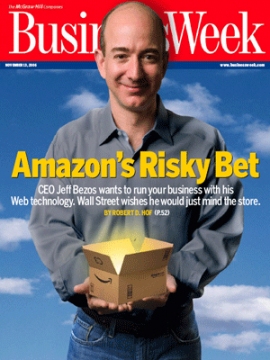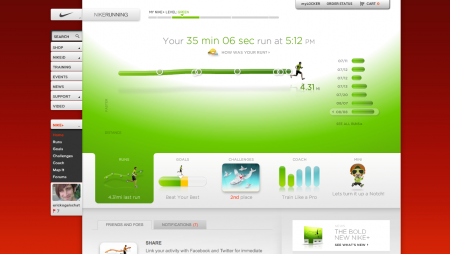The Great Race to Brand the Clouds
The benefits of technology and more specifically the internet, seem to be endless: information and data accessibility, entertainment, commerce, ease of communication, etc. For me, technology is attractive because it makes our lives easier to navigate. The innovation of cloud computing has made this even more apparent. The idea of syncing all of your files (photos, music, documents, etc.) and having accessibility wherever you are, is absolutely amazing. When I was in college at Michigan State University, each student received 100MB of AFS space. AFS is the acronym for “Andrew File System,” it is the central MSU network file storage system, which was originally developed at Carnegie Mellon University in 1984. The idea was to provide a campus-wide file system for home directories. With this, I built my first website. I also used this space to save files for all of my different courses. I could then visit the main library or friends’ dorm rooms and still have access to all my files. I thought this was great, but I used it mainly as a FTP service, which wasn’t very convenient. However, cloud computing is now available to everyone and sometimes completely free.
Many people don’t understand what cloud computing is, although many people use it everyday. Whether you save emails from friends or family in your Gmail or Hotmail account, post photos to Flickr or videos to YouTube; you are saving your files on a network other than your personal computer – this is the cloud. But the cloud is much more intelligent than what I just described. These examples describe hosting solutions for you to save content, but the cloud also provides real-time access to save, edit and share documents, spreadsheets, presentations, music and movies. Many companies like IBM, Microsoft, Google, Amazon and Apple offer cloud computing solutions.
The cloud provides many opportunities for brands to create innovative marketing solutions such as Apple MobileMe, Nike+ or Google Maps. But what company will win? What brand will win the great race to brand the clouds?
What is cloud computing?
Cloud computing, also known as utility computing or hardware as a service (HaaS), is the instant access to dynamic and scalable resources to operate software and applications over the internet. The cloud is defined by six elements:
- Infrastructure (Infrastructure as a Service – IaaS): Is a service providing the seamless architecture and resources (e.g. servers, CPU, memory, etc.) for instant, dynamic and scalable computing power (e.g. Grid computing, virtualization, etc.)
- Storage: Is a service simply allowing you to store your content (e.g. Rackspace)
- Platform (Platform as a Service – PaaS): Is the service that provides hardware and computing software allowing you to remotely access and operate your cloud server to develop, test, deploy, host and maintain applications (e.g. Microsoft Azure Services Platform, Amazon Web Services, Apple MobileMe, Microsoft Live Mesh,etc.)
- Applications: Are the tools that provide functionality to perform various computing tasks, such as uploading creating, editing and sharing documents, spreadsheets or presentations (e.g. Google Docs: Document, Spreadsheet, Presentation, Form)
- Software/Service (Software as a Service – SaaS): Is the service that delivers and is utilized in real-time over the internet (e.g. Google Maps, OpenID, PayPal, etc.)
- Client: Is the computer hardware/software dependent on cloud computing in order to operate (e.g. Mozilla Firefox, Palm Pre webOS, Google G1 Android, Apple iPhone OS)
The idea behind the cloud seems so natural, why not have access to everything you want, whenever you want? Moreover, why not use another network other than your own? Especially if it’s cost efficient. In a Wired article titled “Cloud Computing. Available at Amazon.com Today,” Spencer Reiss and the CEO of Amazon, Jeff Bezos, discuss the cloud:
“Utility computing is Web 2.0’s version of rocket fuel. ‘You don’t generate your own electricity,’ Bezos says. ‘Why generate your own computing?’ The forces driving online apps — internet bandwidth and reliability — also mean that, in terms of data per dollar, servers in your closet or co-location facility can’t compete with industrial-scale bits piped in from hundreds, even thousands, of miles away.”
The Cloud: Strengths
- Accessibility: Cloud-based services allow you to retrieve data and information wherever you are: home, work or play – as long as you have an internet connection
- Captivating: These services become a part of your daily life because they provide utility and convenience
- Convenience: The ability to access files, music and photos no matter where you are
- Content Generation: Users are able to create content wherever they are and in some cases in places they normally wouldn’t
- Inexpensive: The cost to utilize the cloud varies. The current cost structure is either free, based on a monthly subscription or by frequency of use
- Instant Computing Power: Every computer is limited to certain level of power, however with the cloud you can use someone else’s computing power instantly without purchasing another hard drive
- Scalability: As you require additional space to conduct more work, the cloud allows you to readily increase resources
- Synchronization: My personal favorite benefit of the cloud, the ability to sync online and files on other computers
- Usefulness: This is the true strength that every brand should utilize. The cloud can support many different services that provide utility
The Cloud: Weaknesses
- Profit Margins: In a Wired article titled “Microsoft’s Ray Ozzie Sees Lower Margins From Cloud Computing,” Reuters explains that “Microsoft Corp’s chief software architect says the profit margins on providing online services — broadly known as cloud computing — would likely yield a lower profit margin than the company’s existing software business.” This obviously isn’t a disadvantage for consumers, but for companies, the margin from software is greater than cloud computing
- Reliability: The reliability of cloud computing can be an issue. If your internet connection goes down, you won’t have access to your most important files (e.g. Google doc or map)
- Speed: The efficiency of your infrastructure and internet connection will affect performance; and depending on the platform you are using, this may help or hinder performance
- Ubiquity: While the cloud-based service you use for your personal files are technically available all the time, anywhere; you may not always have access due to internet accessibility or connection speed
The Cloud and Branding
Understanding the advantages and disadvantages of the cloud allows brands to utilize the inherent drama of cloud technology to create innovative marketing solutions. In an ADWEEK article titled “Investing in the Cloud” Bob Greenberg, the chairman, CEO of R/GA, explains that “there is absolutely no reason why brands can’t get into this game. At its core, cloud-based marketing is powered by a simple idea: be useful to your customers and they in turn will be loyal to your brand. The cloud is a massive engine of technological utility, with myriad ways to be useful to customers.” More specifically, the cloud allows brands to create marketing services that:
- Provide utility. Brands have the opportunity to augment current services or create new services that are useful in the daily lives of their customers, which could enhance their brand image and loyalty
- Create an engaging experience. These interactive services captivate customers
- Encourage content generation. As consumers continue to use these services, they are directly fueling the cloud-based service with new content as it is integrated into their daily lives
- Utilize a new medium. As Greenberg explains, “…by building cloud-based services, brands create instances of “owned” media. These media channels have reach, frequency and 100 percent relevance with the intended audience.”
- Decrease media budget. As Greenberg explains, “…the old investment model for advertising was based on roughly a 20/80 split: spend 20 percent of the budget conceiving and producing the idea, and 80 percent on media delivering the message. The cloud-based service model inverses this split: spend the lion’s share developing the technology and just a small amount on a bit of paid media to spark awareness. Beyond that, “earned” media takes over and consumers and PR channels spread awareness virally to drive further adoption.”
- Utilize a new financial model. Brands must continue to support advertising campaigns by investing in media otherwise results will be nonexistent. However, production for cloud-based services is inexpensive and continues to reach consumers frequently as they become dependent on these useful services to help navigate their lives. Over time, the cloud will decrease marketing costs
Below are case studies of brands that understand and embrace the cloud as part of their offerings as well as a few brands that just don’t understand the cloud.
Amazon Web Services (AWS)
One of the pioneers of cloud computing is Amazon. Cloud computing became a solution for Amazon when they were on a journey to discover something very different. In 1999, Amazon wanted to open its storefronts up to third-party selling, all in response to eBay. At the time, it seemed odd that Amazon would open the doors to third-parties, but in Jeff Bezos’ words, “If you’re trying to have not just every book but every out-of-print book, every indie-band CD, and every vinyl record, there’s no way you’re going to do it on your own. You have to open up.” The result was Amazon auctions, which later became the current Amazon Marketplace. But to make this idea a reality, they had to solve technical problems with speed, reliability and scalability to support these third-party storefronts on their databases and servers. This resulted in a new architecture with unexpected opportunities. As stated by Spencer Reiss in a Wired article titled “Cloud Computing. Available at Amazon.com Today,” Amazon’s next new business was “opening not just the store in the sky, but the very silicon and software that keeps it aloft.” Reiss further explains that:
“AWS capitalizes on Amazon’s combination of computational skills and operational savvy. It piggybacks on a multibillion-dollar IT infrastructure. And it pulls in a whole new category of customers looking for rock-solid scalable computing on demand — blue-chip startups like Zillow and PowerSet, kids in garages building the next Google, even adventurous corporate IT jocks looking to offload some of the drudgery.”
AWS is an example of a cloud computing platform (platform as a service – PaaS) and leverages all of the cloud’s advantages. What’s interesting about AWS is that it wasn’t created as a product, but as a byproduct from another idea. Regardless, Amazon successfully utilized the cloud to develop a cloud service that companies and individuals will utilize. Further, as Amazon continues to refine its service, the overall brand image will be augmented and hopefully brand loyalty will follow in other Amazon services. I think it will.
New York Times
Similar to how Google Books allows users to search full text from millions of books, the New York Times as digitized over 150 years worth of newspapers into searchable PDFs all of which are hosted on Amazon’s cloud servers. This is a great example of a brand facing pressure to remain relevant as emerging media changes the landscape. Again, providing useful information in a convenient manner and planning for future growth. FYI: Twitter and Justin.tv also utilize AWS to host data and information.
Google Docs
If you are not familiar with Google Docs, the video above by Common Craft provides a great explanation, in plain English. Google Docs provides every benefit that the cloud can offer, everything from convenience to scalability to synchronization. And actually, scalability will be even more evident with the future release of the GDrive, which will allow consumers to purchase additional space for their Gmail, Docs or Picasa photos. Search was the main service that Google provided, however they saw the opportunity in the clouds and beat Microsoft to claim the cloud-based word processing and spreadsheet market. While Microsoft’s cloud-based Microsoft Office Live Workspace is available, it was Google that really took advantage of the cloud. Of course hindsight is always 20/20, but the inherent problem with word processing and spreadsheet files was that you didn’t have one central version – the cloud made this possible. Google saw this opportunity and seized the moment.
Nike+
Nike+ is a perfect example of what brands can accomplish by utilizing the cloud to augment or create products/services that become a part of people’s lives and change it in a positive way. For those runners that have a Nike+iPod, upon completing a run, they can sync their iPods and upload their data to the Nike+ website. Here is where the beauty of the cloud works. Once runners visit the site, they can review a dashboard of recent runs, set goals and create challenges or training programs. And even sign-up for online and offline events, such as The Nike+ Human Race. All of this information is saved in the clouds and users have the ability to access it via the Nike+ application (i.e. website). The Nike+ sensor and chip may technically be the product Nike sells, however it is the service and experience they provide that makes this an amazing brand experience. On a personal note, I have been using Nike+ for almost three years now and absolutely love it. Only a few months ago, shortly after Wired featured Nike+ on the cover for unleashing the power of personal metrics, Nike with the help of R/GA completely redesigned the Nike+ website. It’s beautiful. Usability has been enhanced. And social media tools have been integrated to help extend awareness of the product/service to a larger audience.
Fiat eco:Drive
Together, AKQA and Fiat created a Nike+ for Fiat vehicles called Fiat eco:Drive. Utilizing a USB drive, this technology tracks your driving technique and the online application than analyzes your driving style to help you improve how efficient you drive in order to use less fuel, which will reduce your CO2 emissions and save you money. Similar to Nike+, users can share their information with a community, called Ecoville. Again, it’s this cloud-based application that allows users to reference data and better understand how they can change their driving style to help the environment. Users do not save their information on their personal computers, but in the clouds. Very impressive.
Kodak Gallery
Similar to Flickr, Kodak provided a free online photo gallery service where users could save, print and share their photos. This business model was sustained on the hope that customers would at some point, opt-in for premium services to offset the free users, also known as the “freeium” model. However, Kodak Gallery decided to change their business model. In an AdAge article titled “This Cloud (Computing) Has No Silver Lining,” Matthew Knell explains that Kodak began requiring “users to make minimum purchases in order to subsidize the use of its websites and kill its “freemium” model. The new plans range from $4.99 to $19.99 per month. And if you don’t pay the fee or provide a minimum purchase by a given date? Your photos will be deleted.” This is a problem many online newspapers are experiencing right now. As newspapers continue to lose subscribers, many online versions of the newspapers (e.g. Wall Street Journal) are asking users to subscribe for premium online services. But even the Wall Street Journal still provides some free online services. Kodak essentially implemented a bait and switch tactic to lure customers in and quickly changed their business model. By changing their business model, Kodak ruined their brand image and may have ended the loyalty that many of the users had. While the cloud service that Kodak initially provided fulfilled the users’ expectations of accessibility, convenience and price – by changing their service, Kodak removed what may have been the most important benefit to its customers. Before brands develop cloud services, they must plan for the future. If you foresee that you may have to charge your users in the future, do so at the onset and provide a service that is worth the financial commitment.
Evernote
And now for the number one reason I love the cloud, data synchronization. There are many brands out there right now that are developing apps or services around this benefit: Apple MobileMe, Microsoft Live Mesh and Evernote. This technology allows users to sync files, folders and other data across multiple devises. Evernote’s tag is “Remember Everything” and this is completely true. Users are able to create content, sync it on their computer, mobile phone or online and then access it anywhere. I downloaded the Evernote app for my Palm Pre, but I have to wait until I purchase Leopard for my Mac.
The Great Race to Brand the Clouds
The cloud inherently provides many opportunities for brands to create innovative marketing solutions such as those listed above. To answer the question I posed earlier, what company will win? What brand will win the great race to brand the clouds? The answer is every brand that embraces the cloud and creates new services that are engaging and encourage content generation, and utilize a new medium that is cost effective. Lastly, as Bob Greenberg explains in an ADWEEK article titled “Investing in the Cloud” the cloud “is about the democratization of technology – and democracy is a good thing. Make sure your brand participates.” However, while it is a democracy, I believe a few brands make it a monarchy:
- Amazon branded the clouds as a platform (Platform as a Service – PaaS). Interesting note, Amazon was the first company to sell cloud computing as a service
- Google branded the clouds for utility applications. While Microsoft does have their full Office suite available online, Google made a bigger impact
- Nike+ branded the clouds for entertainment applications. As of yet, we have not seen anything as integrated into the lives of its users
















